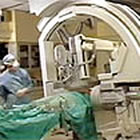| << To Blog Home >> | |
|
|
January 21, 2012 -- 8:05pm EST FAME II Is Not the "Anti-COURAGE": Stents and Angioplasty in the Spotlight
So is this, as several analysts have suggested, a reversal of the COURAGE trial results? Not according to the principal investigators of both the FAME II trial AND the COURAGE trial, whom I have spoken with in the past 48 hours. I will be posting an in-depth article in the next couple of days about this issue, which is extremely important to the interventional cardiology community. But suffice it to say that both Dr. William Boden, PI for the COURAGE trial, and Dr. Bernard De Bruyne, PI for FAME II agree that the two trials do not negate each other at all, because the patient populations are not the same. FAME II only enrolled patients who had ischemia, documented via Fractional Flow Reserve (FFR). In that population, PCI (a.k.a. stenting or angioplasty) was shown to be the best option. In COURAGE, a much broader patient group was enrolled, using angiographic evidence of blockage of 70% or more. FFR was not used. And in COURAGE, there was no difference in outcomes between patients who had PCI plus OMT, or those who had OMT only. The important finding here is that, when FFR is used as a guide to therapy, PCI is validated as the best option -- without question! But when visual imaging via angiography is the only diagnostic tool, the value of stenting can be debated -- as it has been in numerous controversial cases in Maryland (Dr. Mark Midei, etc.) and Pennsylvania and in many other hospitals. The conclusion, for us at Angioplasty.Org, is that FFR should be used as a mandatory part of all angiograms: in order to clearly document ischemia. Why subject the patient to a catheter-based procedure, with all of the possible adverse events that are seen, and not spend a few minutes performing an FFR measurement -- one which will validate the future course of therapy? Comments? |
|


